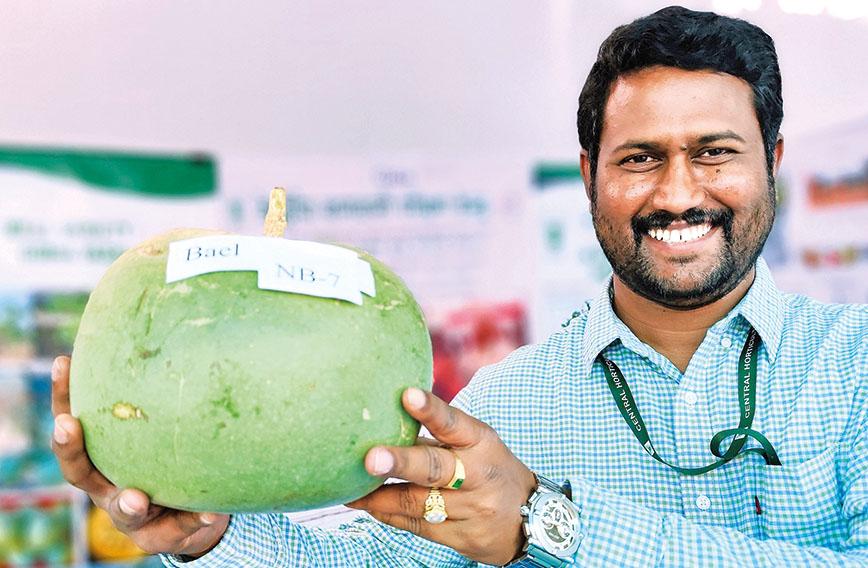
The NB-7 bael variety weighs as much as 7 kg and is pulpier
The new and juicy bael has arrived
Shree Padre
In the blistering summer of northern India, everyone is familiar with the benefits of a soothing glass of bael juice. But the humble and drab-looking fruit’s popularity soon fades when the weather changes. In the hierarchy of the fruit kingdom, it ranks at the bottom in terms of appeal and is nowhere in the reckoning with a star like the mango.
Bael however may be poised for better recognition and indications are that it could be on the verge of a Cinderella moment. Far from public view, several agricultural scientists in India have been developing new varieties of bael that, though not more attractive than the original, are larger and juicier and offer possibilities for commercial processing.
With these modifications, bael has gone from a mere 200 g to 7 kg — a whopping transformation. As a result, prospects of newfound demand are being envisioned. Hitherto grown almost entirely in northern India, a boom area could be in the making in the southern states. Karnataka, for instance, has big plans for planting the new varieties.
“India has an estimated 25,000 hectares under bael cultivation, which makes it the biggest grower of the fruit in the world. Our estimated annual production is 175,000 tonnes,” says Dr A.K. Singh, head of the Central Institute for Arid Horticulture (CIAH) in Godhra, Gujarat.
The shift to the south when it happens will be a multiplier because currently all the production happens in Uttar Pradesh, Madhya Pradesh, Rajasthan and Bihar. And there are some plantations in Gujarat.
In the south, the bael has a juiceless indigenous cousin the size of a potato which is often confused with the wood apple. But of course, a status change could be coming up with the new varieties being planted.
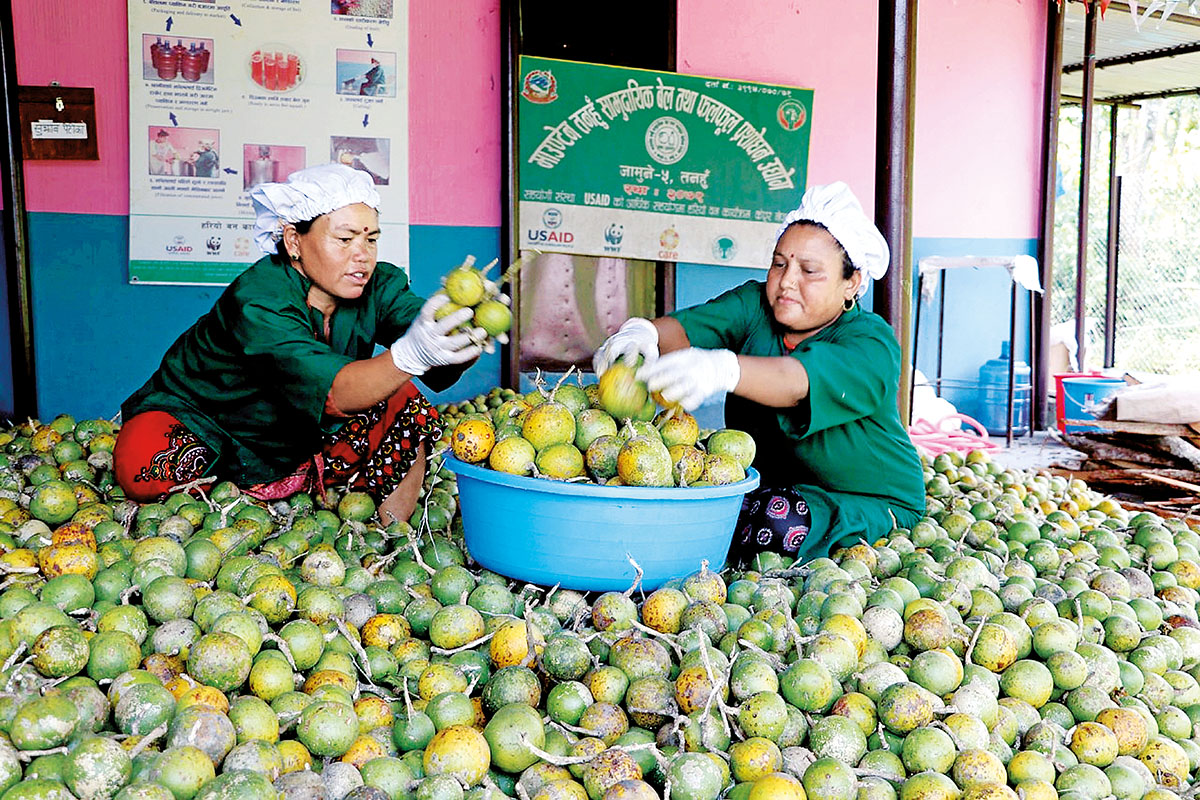 Women sort freshly harvested bael at the Central Institute for Arid Horticulture
Women sort freshly harvested bael at the Central Institute for Arid Horticulture
Labelled a ‘minor fruit’ by the Indian Council of Agricultural Research (ICAR), the bael hasn’t received the attention it deserves. Fact is that it is full of nutritional value. Every part of the fruit — stem, bark, root, leaves, seeds and pulp — has medicinal benefits according to a research paper in the Journal of Medicinal Plants Studies. A glass of bael juice comes packed with antioxidants, we are told. A murabba or preserve is also made from its ripe pulp.
Bael has been used in Ayurveda and community medicine for centuries to cure gastrointestinal conditions. The bioactive compound of this fruit is marmelosin. The leaves are believed to be anti-diabetic. It has a high content of riboflavin.
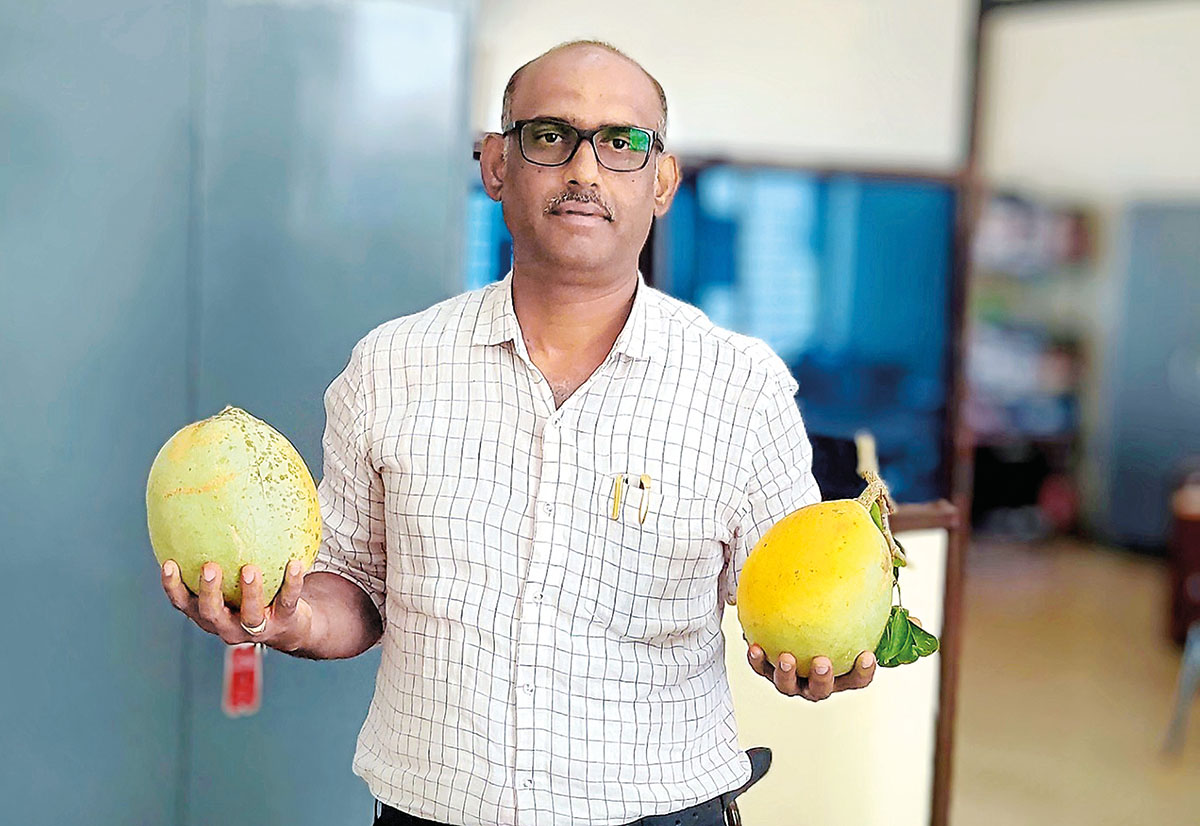 Dr Anand Nanjappanavar of University of Agricultural Sciences in Bagalkot with the fruit
Dr Anand Nanjappanavar of University of Agricultural Sciences in Bagalkot with the fruit
Botanically known as Aegle marmelos, the rotund bael fruit has a hard exterior and a soft interior. The pulp inside, full of seeds, is used to make sherbets. You can mix it with water and a squeeze of lime, or blend it with milk and sugar, or add tamarind paste.
It doesn’t need much effort to grow bael and it thrives in drier regions since it consumes very little water. The Central Institute for Arid Horticulture (CIAH) in Bikaner, Rajasthan, has been studying bael for decades at its Central Horticultural Experiment Station at Godhra, Gujarat, and has released nine varieties.
The Acharya Narendra Deva University of Agriculture and Technology (ANDUAT) in Ayodhya in UP, has also been in the forefront of bael research and has released eight varieties. So has the G.B. Pant University of Agriculture & Technology in Uttarakhand which released four varieties in the mid-1990s. The Central Institute for Subtropical Horticulture (CISH) in Lucknow has brought out two varieties.
Altogether, these four organizations have released 23 improved varieties of bael so far.
The biggest variety, NB-7, achieves the size of a coconut and can weigh up to 7 kg, which is a huge improvement over the wild varieties.
The scientifically enhanced varieties have distinct advantages, being not just bigger, but sweeter, pulpier and with fewer seeds. They have aroma and flavour of their own and grow faster too.
Dr H.K. Singh, professor, department of fruit science at ANDUAT, shortlists three new varieties he finds eminently suitable for cultivation: NB-5, NB-7 and NB-9. “In all three, seeds and mucilage are less, the rind is thin and you can crack open the fruit with your fingers. The NB-7 variety is the biggest,” he confirms.
At the G.B. Pant University of Agriculture & Technology, Dr V.P. Singh, a professor of horticulture, recommends Pant Shivani as the best variety. “It is well suited for arid regions. The fruit is 1.25 to 1.5 kg in weight, and ideal for nuclear families.”
Shell and pulp
Bael, however, is not a table fruit. “You can’t cut it and eat it like a mango. You have to break its shell and eat its pulp. Generally, it is made into juice. True, bael isn’t as popular as the mango. But its medicinal properties are many times higher,” says Dr A.K. Singh.
People in the South are familiar with bael which is called bilwapathri and used for Shiva puja. But news about improved varieties of bael has not percolated to them. The south Indian variety, a wild or desi one, is small, not edible and does not yield juice. There’s also confusion about its nomenclature. In the North, the Aegle mermelos tree is called bael. In the south, a similar looking fruit is called bael when in reality it is the wood apple or Limonia acidissima.
“Bael or Aegle marmelos is green and its shell has a soft texture. In comparison, wood apple or Limonia acidissima has a brown shell with a rough surface,” explains Dr A.K. Singh.
Bael requires a dry, warm climate. While plants raised through seeds take many years to fruit (five to eight years), grafted plants start yielding in barely four years. The improved varieties will do well wherever wild bael trees are surviving, says Dr A.K. Singh.
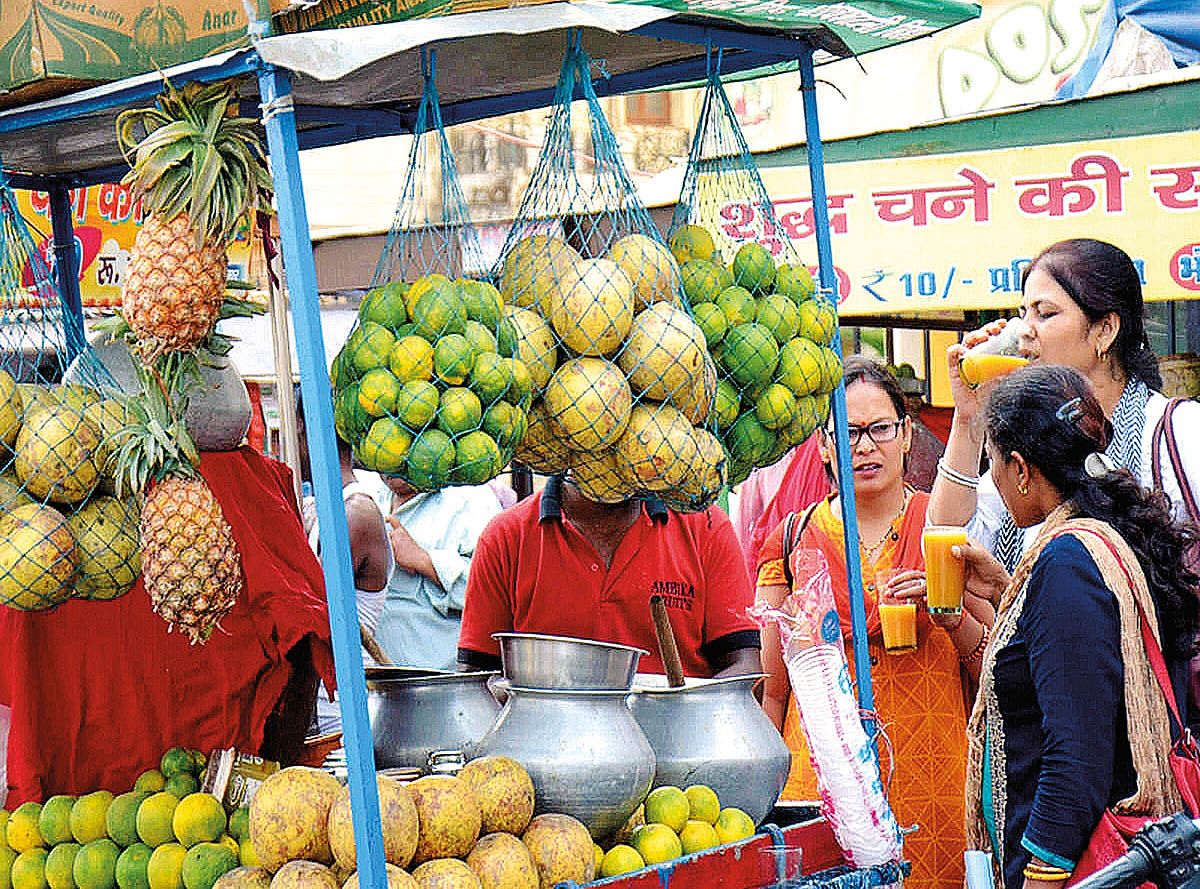 In season bael is a popular juice
In season bael is a popular juice
The fruiting season of bael is from January till end-June. Seedlings generally give a stabilized yield after the ninth year. An acre of bael yields 60 to 70 tonnes of fruit. Generally, fruits are sold by count. In Delhi, bael sells for Rs 25 a fruit. In Rajasthan, it costs around Rs 40
per fruit.
“Bael is a pretty hardy tree. It comes up well in black cotton soil too. Sloping land is ideal for cultivation. Just avoid fields which are prone to waterlogging,” says Rajendra Chourey, owner of Shayona Biotech in Gujarat.
In the Thar desert, bael plants that get buried under sand for two or three months wondrously rejuvenate on their own, an indication of ruggedness. Bael can tolerate salinity too up to certain levels. However, well-drained sandy loam soil is ideal for bael orchards. The plants can easily grow in wasteland and sandy soils of arid ecosystems with poor moisture-holding capacity.
Chourey says, “Everyone is after some exotic fruit. People do not know about our desi fruits. We have to highlight the medicinal values of bael to make it popular. Bael is a sure cure for constipation — just swallow a spoon of bael murabba. Secondly, bael juice is very cooling in summer and with heat waves rising, it will be more in demand.”
An incipient industry
A few processing units have come up but bael’s true potential has remained largely untapped. The Navsari Agricultural University (NAU) in Gujarat produces bael powder, juice, and a spiced syrup that can be used as an appetizer.
“People do know about the medicinal uses of bael. But processed products of the fruit are not widely available. Urban consumers would prefer to buy ready-to-serve bael juice off the shelf rather than having to make juice out of bael pulp. Making such products will increase its popularity,” says Dr Dev Raj, head of post-harvest technology at NAU.
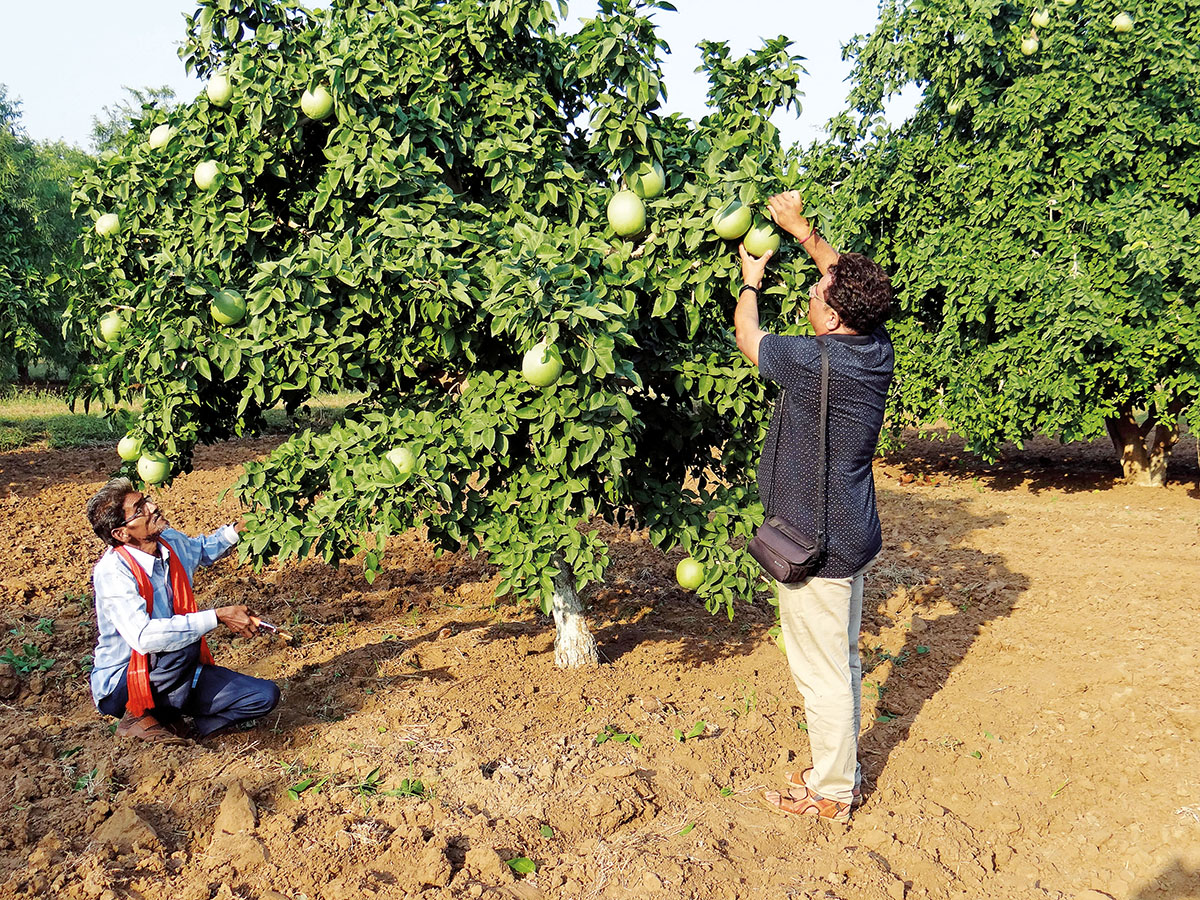 The hardy bael tree thrives in a warm, dry climate
The hardy bael tree thrives in a warm, dry climate
In the past five years, some companies have seized the initiative. “Baidyanath and Patanjali are introducing bael squash that is attracting consumers,” says Dr S.P. Singh. Then, under the One District, One Product (ODOP) scheme, in Pratapgarh district of UP households and numerous small industries are making products from bael and amla. These are sold in cities and towns in UP itself, says Dr H.K. Singh.
Abadari, a farmer-producer company (FPC) in Banganpara, Assam, launched a ready-to-serve bael drink last year. Anantha Ramchiary, founder of the FPC, says, “We get enough local varieties of bael near our processing unit. These yield a good quantity of juice. Our ready-to-serve drink got a good response.”
Abadari plans to increase its output this year. The FPC also makes herbal tea powder from bael leaves which is sold in exhibitions.
Dr H.K. Singh points out that, now and then, villagers come to their farm asking if they can take some bael leaves to consume as a cure for diabetes. However, no clinical studies have been done to ascertain the medicinal properties of bael.
Southern sojourn
The bael is being grown marginally in Karnataka. The Indian Institute of Horticultural Research (IIHR) in Bengaluru planted improved bael varieties of some of the NB series 20 years ago. The seedling progenies of those mother plants are yielding fruits which are around 800g to 1kg in weight.
C. Sathyamurthy, a farmer in Thali on the Karnataka border, has five 20-year-old bael trees. He has forgotten where the plants came from. Each tree yields 20 to 50 fruits which weigh 300 to 450 grams. “These fruits have fewer seeds and more pulp, which is sweet. I make it into a sherbet with jaggery,” he says. Sathyamurthy was unaware that the fruits were edible until some quarry labourers made sherbet out of his fruits.
The Bagalkot Horticulture University had planted a few improved bael grafts more than 10 years ago. Thirteen trees are yielding fruits of around two kg each. “We didn’t need to pay much attention to these plants, apart from watering them in summer. The fruits are tasty,” says Dr Anand Nanjappanavar, farm superintendent.
Prasad Ramappa, a retired chief engineer with a farm in Harohally in Ramanagar district, planted a bael graft ten years ago. It started yielding fruit in three years. “The fruit weighs around one kg and is tasty. I get a good yield. I give the surplus to friends,” he says.
Ramappa as well as Bagalkot University had bought grafts from Teja Nursery in a Bengaluru suburb. “I have been getting these grafts from Kolkata for many years. They call them edible bilwa. These are juice varieties,” says Shivanapura Ramesh, owner of the nursery.
Into the forest
Karnataka’s forest department is keen to introduce the bael tree in forests under its care. “Bael is a tree of immense economic, medicinal, and ecological importance,” says A.K. Singh, additional principal chief conservator of forests. “The department can promote the cultivation of high-yielding and resilient bael trees, benefiting local communities and ecosystems.”
While the forest department has done considerable work in selecting the best cultivars of bael, it is facing challenges. They have had limited success in grafting. Also, documentation on grafting trials of the fruit is not readily available.
The forest department’s best bet would likely be to reach out to the four agricultural universities that have already introduced new varieties. They can get their staff trained there as well.
Two leading private nurseries, Shayona Biotech in Gujarat and VNR Nursery in Chhattisgarh, have an MoU (memorandum of understanding) with CIAH to propagate their bael varieties. They have promoted more than 15 new varieties of bael in the past 15 years.
Devesh Shukla, founder of VNR Nursery, is a post-graduate in agriculture who travels extensively and promotes indigenous underutilized fruits like bael, jamun, karonda and jackfruit. Post-Covid, he says, fruits with medicinal qualities have been rising in popularity.
Bael hasn’t been popular because it was hard to break and had excessive mucilage and seeds. But the new varieties have juicy pulp and are very sweet. Shukla thinks bael now has a bright future thanks to the new varieties.
“For any crop to be popular, you need a national campaign,” says Shukla. “Take the example of millets. After the Millet Mission began, millets began to be introduced in biscuits, roti, beverages, cereals and more. If you want to eat millets, you have a wide choice today.”
The problem, he says, is that the government’s agricultural extension system is weak. Take the Amrapali mango. It was released in 1978. But it took several decades to popularize it. “The basic drawback is that neither farmers nor customers knew about the Amrapali. Have you ever heard of the IIHR telling fruit vendors or retailers about their new fruit varieties? They are the people who can popularize and sell new varieties but they are not even informed,” says Shukla.
VNR Nursery became famous for its guava variety called VNR Bihi which it managed to sell on its own. “We take a big stall in exhibitions which display huge visuals. Only the fruit to be promoted gets priority. Visitors are offered a piece of the fruit to taste. We send MBA students with our catalogue to fruit wholesalers. They explain how this particular fruit is superior. This is how our VNR-Bihi, released 13 years ago, reached 25 states and is being grown on about 10,000 acres today,” says Shukla.
 The Goma Yashi bael is gaining popularity because of its softer shell
The Goma Yashi bael is gaining popularity because of its softer shell
Karnataka has the highest drought-prone area in India and is therefore ideal for bael cultivation. Bael is also well suited to the state’s degraded soil and black cotton soil regions. “Bael fruits have a long shelf life of 12 days. Farmers can supply their fruits to markets in North India,” says Shukla. “In this, agricultural universities in Karnataka’s rainfed zone can play a big role.”
But are the agricultural universities interested? Three of them said they were keen. “Our Regional Agriculture Research Station in Bijapur falls in a very dry belt. We have 50 acres where we can take up trial cultivation of the best varieties of Aegle mermelos. Our Bijapur Krishi Vijnan Kendra too can start experimental cultivation,” says Dr P.L. Patil, vice-chancellor of the University of Agricultural Sciences, Dharwad.
In Raichur, Dr M. Hanumanthappa, vice-chancellor of the University of Agricultural Sciences, said they were considering planting the fruit. “We plan to assess the suitability of improved bael cultivars and standardize production techniques for selected varieties. Since bael is known for its medicinal properties, drought tolerance and ability to grow in poor soils, we are keen to undertake trials here.”
He said bael was a good option for Raichur’s farmers since the area has a semi-arid climate with moderate rainfall. It can also be integrated into agro-forestry projects and farming systems and cultivated as a commercial orchard.
In Bagalkot, Dr Vishnuvardhana, vice-chancellor of the University of Horticultural Sciences, says his area has a salinity problem and new crops are being tested for their performance. Apart from Bagalkot, five areas have been identified for trial cultivation of bael — Dharwad, Thidagundi, Vijayapur, Hogalagere and Srinivaspur. They are also in touch with scientists in CIAH, Godhra.
Shukla suggests that grafts be distributed to farmers in areas surrounding the agricultural universities. This would make cultivation spread, and possibly give rise to a spate of downstream industries.
After Adike Patrike, an agriculture magazine in Kannada, did a cover story on the fruit’s potential, the response was enthusiastic. A WhatsApp group has been formed to promote the fruit. Seven drought-prone districts in north Karnataka have been identified as most suited for trial plantations of the fruit.
“Bael seems to be the most suited fruit for districts in Karnataka from Kolar till Bidar, considering the soil type, rainfall, humidity and other factors,” says Dr Jagadish Rane, Director, CIAH in Bikaner. “The interest it has generated can be taken into mission mode. But first we need to assess through trial cultivation the best suited varieties for each of the seven drought-prone districts.”
Contact: CIAH in Godhra: Dr A.K. Singh – 94265 75966 / Dr Gangadhar K. – 8849768762; Dr H.K. Singh – 94157 20179
Comments
-

Arvikd Kumar Singh - May 30, 2025, 5:03 p.m.
Nicely written and very informative to all stakeholders





